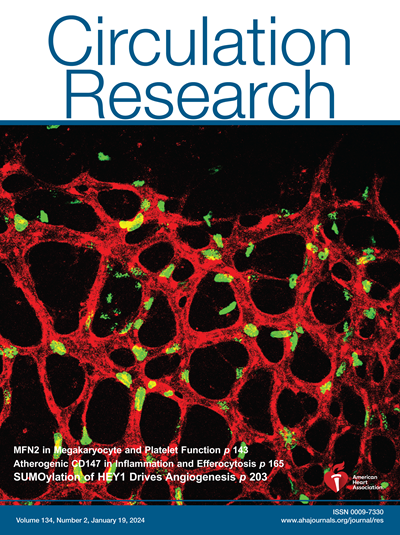Bacterial Infections Shape Cardiac Macrophages' Response to Ischemia.
IF 16.2
1区 医学
Q1 CARDIAC & CARDIOVASCULAR SYSTEMS
引用次数: 0
Abstract
BACKGROUND Patients with bacterial infections are at increased risk for subsequent cardiovascular events. Whether infections' effects on innate immune cells within the cardiovascular system influence subsequent pathologies remains unclear. Here, we explore cardiac myeloid cells' chronic adaptations to a preceding bacterial insult and implications for subsequent myocardial ischemia. METHODS We used various flow cytometry protocols to assess cardiac immune cells, peripheral leukocytes, and hematopoietic stem and progenitor cells in bone marrow and spleen. A genetic fate-mapping model was used to determine cardiac macrophages' origin after bacteremia. Cardiac leukocytes were analyzed using scRNAseq. Nanoparticle-mediated RNA interference was used to target macrophages in vivo. RESULTS Cardiac macrophage numbers increased sharply, and numerical changes alongside subset alterations persisted over time. Fate-mapping pointed toward local origin as the primary macrophage source after infection. Profiling macrophage heterogeneity using scRNAseq, we identified 2 previously unknown subpopulations remaining after resolution of infection. While heightened metabolic activity was one subset's primary feature, the other displayed excessive chemotactic properties, which amplified cardiac leukocyte recruitment and inflammation after a subsequent ischemic injury. Targeting cardiac macrophages' surplus inflammatory activity after infection using nanoparticle-enabled, macrophage-directed RNA interference kept disproportionate subsequent ischemic inflammation at bay. CONCLUSIONS Bacteremia induces long-lasting changes in the cardiovascular system's innate immune cells' composition. This may amplify myocardial inflammation after a subsequent ischemic injury.细菌感染影响心脏巨噬细胞对缺血的反应。
背景:细菌感染患者发生后续心血管事件的风险增加。感染对心血管系统内先天免疫细胞的影响是否影响随后的病理尚不清楚。在这里,我们探讨了心肌髓细胞对先前细菌损伤的慢性适应及其对随后心肌缺血的影响。方法:采用不同的流式细胞术检测心脏免疫细胞、外周血白细胞、骨髓和脾脏造血干细胞和祖细胞。采用遗传命运定位模型确定菌血症后心脏巨噬细胞的来源。使用scRNAseq分析心脏白细胞。利用纳米颗粒介导的RNA干扰在体内靶向巨噬细胞。结果:心肌巨噬细胞数量急剧增加,随着时间的推移,数量变化和亚群改变持续存在。命运图谱显示局部来源是感染后巨噬细胞的主要来源。使用scRNAseq分析巨噬细胞异质性,我们确定了感染消退后遗留的2个以前未知的亚群。虽然代谢活动增强是其中一个亚群的主要特征,但另一个亚群表现出过度的趋化特性,这在随后的缺血性损伤后放大了心肌白细胞募集和炎症。利用纳米颗粒激活的巨噬细胞靶向感染后心脏巨噬细胞的剩余炎症活性,巨噬细胞定向RNA干扰可阻止不成比例的后续缺血性炎症。结论菌血症引起心血管系统先天免疫细胞组成的长期变化。这可能会在随后的缺血性损伤后放大心肌炎症。
本文章由计算机程序翻译,如有差异,请以英文原文为准。
求助全文
约1分钟内获得全文
求助全文
来源期刊

Circulation research
医学-外周血管病
CiteScore
29.60
自引率
2.00%
发文量
535
审稿时长
3-6 weeks
期刊介绍:
Circulation Research is a peer-reviewed journal that serves as a forum for the highest quality research in basic cardiovascular biology. The journal publishes studies that utilize state-of-the-art approaches to investigate mechanisms of human disease, as well as translational and clinical research that provide fundamental insights into the basis of disease and the mechanism of therapies.
Circulation Research has a broad audience that includes clinical and academic cardiologists, basic cardiovascular scientists, physiologists, cellular and molecular biologists, and cardiovascular pharmacologists. The journal aims to advance the understanding of cardiovascular biology and disease by disseminating cutting-edge research to these diverse communities.
In terms of indexing, Circulation Research is included in several prominent scientific databases, including BIOSIS, CAB Abstracts, Chemical Abstracts, Current Contents, EMBASE, and MEDLINE. This ensures that the journal's articles are easily discoverable and accessible to researchers in the field.
Overall, Circulation Research is a reputable publication that attracts high-quality research and provides a platform for the dissemination of important findings in basic cardiovascular biology and its translational and clinical applications.
 求助内容:
求助内容: 应助结果提醒方式:
应助结果提醒方式:


